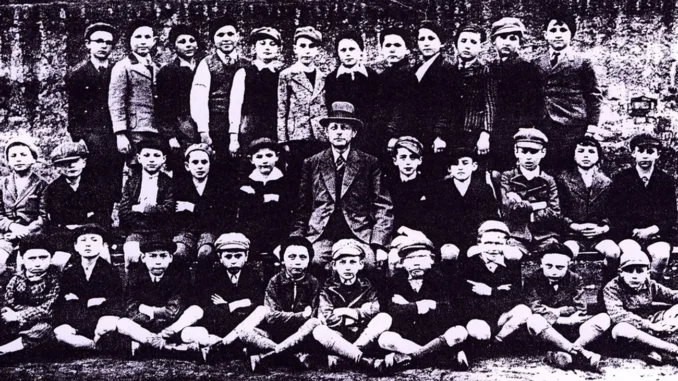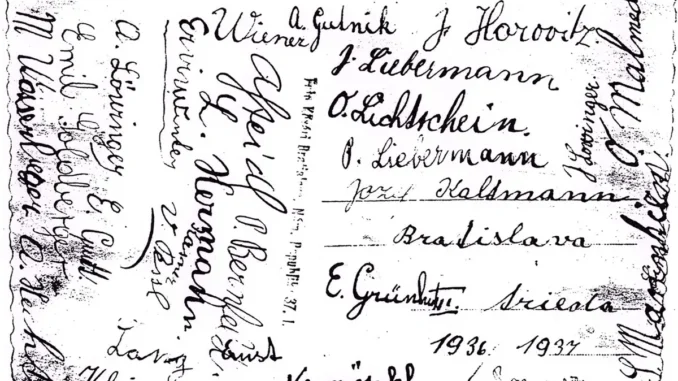E. Rowell: In this article the author explores the ties that bind us to prior generations of Jews. All of the family members from my father and mother’s side of the family who did not leave Europe or Russia prior to World War II perished. It is a strange kind of loss. It is not the loss of loved ones I knew and cared for. It is the loss of family members I never got a chance to know, and lost.
My grandfather kept a picture from his childhood school in prewar Bratislava. Most of his classmates were murdered by the Nazis, but those who survived the Holocaust remained connected for the rest of their lives.
By Nomi Kaltmann, TABLET MAGAZINE 3 May 2024

The author’s grandfather’s class photo/MELBOURNE HOLOCAUST MUSEUM
My grandfather Yossi Kaltmann always kept a picture of his classmates on his living room mantle. The black-and-white photograph of him and more than 30 of his peers was always given a place of prominence. For most people, looking at a photo of their school friends is a form of nostalgia. For my zayde, it was a form of remembrance, because most of his classmates were murdered by the Nazis. Captured during the 1936-37 school year at Bratislava’s Yesodei HaTorah School in Czechoslovakia, the image portrays young Jewish boys aged 8-9, many of whom would only live a few years more before being killed.
The class photo that my zayde displayed was a duplicate of the only known surviving original. His lifelong friend Ernst Neugroschl, who had grown up with him in Bratislava (formerly known as Pressburg), also survived the war. During the war, Ernst had managed to hide some personal artifacts and photos in the thatching of a roof in Nitra, Slovakia, which he retrieved after the war. The class photo was one of these retrieved items.
My grandfather is pictured third from right in the top row, with Ernst in the same row, sixth from right.
After the war, Ernst, who was an only child and whose parents miraculously also survived, moved to Washington, D.C. My zayde, who was the sole survivor of his family, chose Melbourne, Australia. Despite the geographic distance, the two of them always kept in touch.
My zayde and Ernst had the same accent, had both spent time living in Israel after the war, and knew what it was like to survive the destruction of European Jewry. Due to the close bond between the two of them, the Neugroschl family have always felt like my cousins, even though we are not officially related.
Remarkably, the photo that Ernst hid in Nitra had the signatures of many of the boys in their class on the back of it. I love seeing my zayde’s signature, in his childlike scrawl, spelling his name as Jozef Kaltmann, using the German spelling for his first name, Joseph. Ernst’s name is also found on the back. While most boys seemed to have put their first initial and last name, Ernst and Jozef, always best of friends and always as thick as thieves, wrote their full names.
For me, the photo serves as a window into a vibrant Jewish world that has since faded into history. It is also a rare opportunity to see my zayde pictured as a child. He only managed to salvage a few photos of himself after the war, which survived thanks to neighbors who had hidden artifacts for his family. After his parents, sister, and brother were killed, my zayde was the only one left to retrieve the items.
As far as my zayde and Ernst knew, there were only a few survivors from their school photo and they made sure to send any other known survivors a copy. Zayde kept in touch with Anton Fisher, pictured fifth from left, in the middle of the bottom row. Like Zayde, Fisher also chose to live in Melbourne after the war.

The back of the class photo/MELBOURNE HOLOCAUST MUSEUM
When I spoke to Fisher’s widow, Masha, she was familiar with the photo, as it is the only photo that exists of Anton as a child. “I don’t have photos of his childhood,” she said, noting that none had survived the war.
Zayde and Ernst also sent a copy to Benny Grunhut, who, at 97 years old, is still alive and lives in Tel Aviv.
The photo was very important to the boys who survived.
In an email from 2010, Ernst suggested that my grandfather, who had a legendary memory, sit down with my dad and write down the names of everyone he remembered. Ernst added, “The teacher is Mr. Seidl: He is in the middle of the picture, if you can enlarge that picture and ask your father to write down the names of the boys that he remembers.”My father recalls sitting with my zayde and doing just that, but regrettably, despite our diligent efforts to find the labeled photo, we were not able to locate it because it has been misplaced.
With the death of my grandfather in 2016 and Ernst’s death in 2021, the task of identifying the other boys in this photo raises more questions: How many of them survived? What happened to those who didn’t survive?
As I looked at this photo on the eve of International Holocaust Memorial Day earlier this year, I decided to trace some of them, using their signatures on the back. I know not everyone signed it (for example, Anton’s name is not on the back), but despite knowing that I could not identify everyone, I wanted to see if I could honor the memories of those who had been murdered.
Using the Yad Vashem archives, I began sleuthing.
My first search was for the signature of V. Pessl. Almost immediately, I found him: Valter Pessl. A record of testimony lodged in 1957 records that a child by the same name from Bratislava was murdered in Auschwitz in 1942. As I stared at the record, the weight of history pressed upon me, and I couldn’t help but wonder about the untold stories, the stolen potential, and the profound impact that the events of 1942 had on his young life.
My next search for A. Gutnik, another signatory, brought a similarly tragic result. It matched up with a record from Yad Vashem for Alfred Gutnik, also from Bratislava, who was born in 1930 and who died at 12 years of age after he was deported to Auschwitz in 1942.
As I entered O. Malmed into the Yad Vashem archive, the digital veil lifted to reveal Otto Malmed, who like his classmates, was deported to Auschwitz in 1942 and killed in the concentration camp. He, too, was 12. J. Horovitz seemed to match up to a record of Jakov Horovitz, also from Bratislava and recorded by a family member as not surviving the war.
How does one process the trauma of the tragedy of Jewish history? These are not random people. These were my zayde’s and Ernst’s friends and classmates from the Yesodei HaTorah. They were someone’s children, siblings, relatives, and playmates.
More than 80 years on from the Holocaust, how can one comprehend the murder of innocent children?
And yet, there is a certain honor to finding their names and tracing what happened to them. In the almost 90 years since the photo was taken, and more than 80 years since so many of these boys were killed, on earth we say: We remember you. We don’t forget. We bear witness.
From the stories my zayde told me about Yesodei HaTorah in Bratislava, all the boys received a stellar Jewish education. The boys would learn everything by heart; until the day he died, my zayde could recite verses of Torah he learned there.
When I spoke to Ernst’s widow, Joan, she confirmed that Ernst had received the same education: “Before he got ill, Ernst remembered so much baal peh. He knew it offhand. They learned Torah very well. I don’t know, maybe it was the way it was learned, the love they had,” she reflected.
Clearly the bonds between the boys from the Yesodei HaTorah also ran deep.
In 2016, when my zayde was in the hospice, dying of cancer at 87, Ernst called him. Despite Zayde being hours from death and delirious, when we told him it was Ernst on the phone, he knew exactly who it was, and had one of his last lucid conversations.
Zayde and Ernst have now both passed away, and yet, our families remain friends, a testament to friendship between our families that has endured almost 100 years.
Several weeks ago, my sister got married in Jerusalem. We extended invites to our nearest and dearest family members, including the Neugroschl family. To our delight, Ernst’s son Jeff, along with his wife, CB, and four of their five children, would be in Jerusalem on holidays from New York. We were absolutely thrilled.
As the photographer took a group photo of all of us, it reminded me of the original group photo that has bonded our families so closely together for so many years. There was only one thing to shout out; instead of “cheese,” we said: “Bratislava! Yesodei HaTorah 1937!”
Nomi Kaltmann is Tablet magazine’s Australian correspondent. Follow her on Twitter @NomiKal.



Leave a Reply
You must be logged in to post a comment.